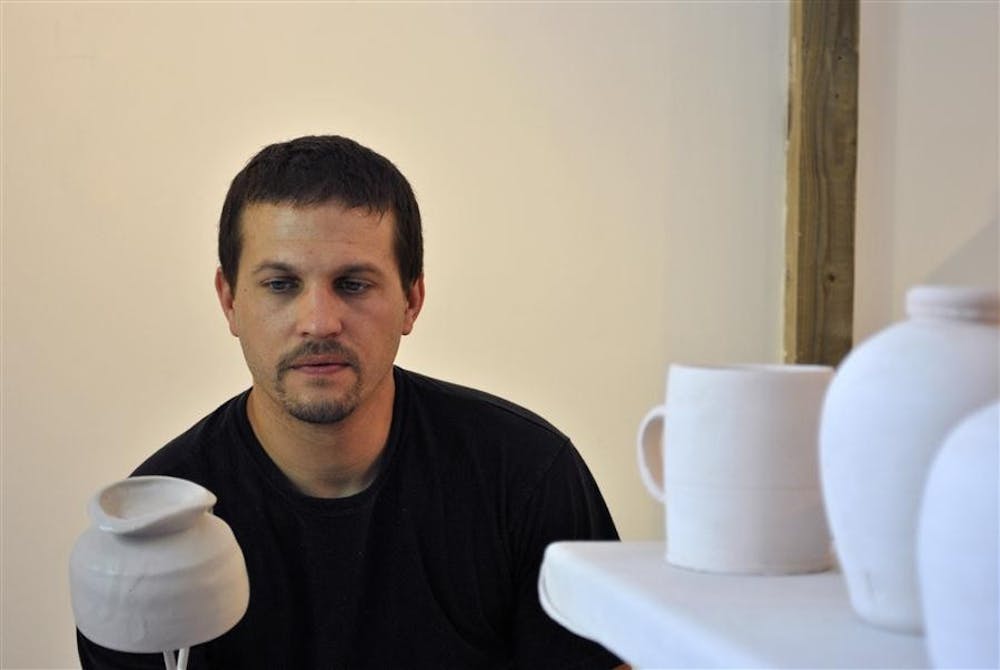For ceramicist and junior Ben Cirgin, an attraction to Japanese- and Korean-style pottery began during a break from school, when he first discovered a passion for clay at the Bloomington Clay Studio just outside of town.
What originally began as a break to figure things out became a creative endeavor that led him from computer science and business to remodeling houses and, eventually, to becoming an instructor at the studio.
Early in the studio’s history, Cirgin decided to take a course on ceramics. He later became good friends with the founders, Daniel Evans and Evans’ wife Shu-mei Chan.
Clay held one great advantage over other media for Cirgin: Its ability to easily change form was a drastic shift from the woodworking and furniture projects he’d previously worked on.
Korean and Japanese pottery, he said, “respect the way clay naturally looks.
“It would seem very loose, but if you watch someone make a Japanese teacup, it will look a little wobbly — but they do it on purpose. ... They know just where they want the wobble to be.”
Cirgin said the studio helped foster his interest in Japanese wood-burning kilns. Wood firing could be one of the most communal — and ancient — activities in the arts.
BCS’s kiln can hold up to four hundred pieces of pottery at once, so, Ben said, there’s a huge vested interest in how the pieces turn out.
The process itself is quite demanding, requiring five continuous days of firing, fueled by wood chopped by studio members and watched until the process is complete. Cirgin said firing work is exciting because of the unpredictability of fire and its effect on the work.
“The whole phase is an adventure,” Cirgin said. “Everybody wants to be there for ‘the catch.’ And then you go back to the wet clay — it’s just a continuous cycle of making and firing.”
The biggest challenge of this style of work, he said, is making it look natural.
“Everything I did used to have to be absolutely perfect and straight,” Cirgin said. “It’s hard to take something man-made and make it look like it was naturally formed.”
The unpredictable nature of firing also makes recreating a piece nearly impossible. An artist, Cirgin notes, can try all his life to recreate a process he used 20 years ago, but it will never come out quite the same way again.
For now, Cirgin’s focus is on researching traditional styles and finding his place within them. His current work on tea bowls has implemented both a sense of tradition and other inspirations he gathered from a summer work-study at the Penland School of
Crafts in North Carolina.
He worked under Judith Duff, who guided students through the process of using traditional Shino glazes, frequently used on tea ceremony pieces.
The variety of work he saw there was something to take home, as artists who worked with materials from “iron to 3-D knitting” collaborated on work and brainstormed wildly original uses of their materials.
Cirgin said he’d like to bring the sense of an artist community to Bloomington.
This fall, Cirgin was admitted to the Henry Radford Hope School of Fine Arts BFA program for his ceramic work. He’s curious about what the program will hold for him and how his background will affect the work he’ll make in the future.
He said someday he’d like to teach ceramics at the collegiate level.
“Fortunately, I was given the chance to teach at the studio — the beginner wheel-throwing class,” he said. “It’s neat to see someone come in, freaked out and scared, and by the third class make some kind of a cup or bowl. You really get to see a class of six or seven people come together. That’s what I want to do.”
Pottery offers sense of community for artists

Get stories like this in your inbox
Subscribe





